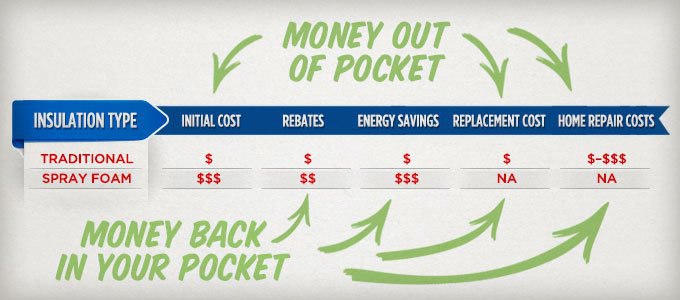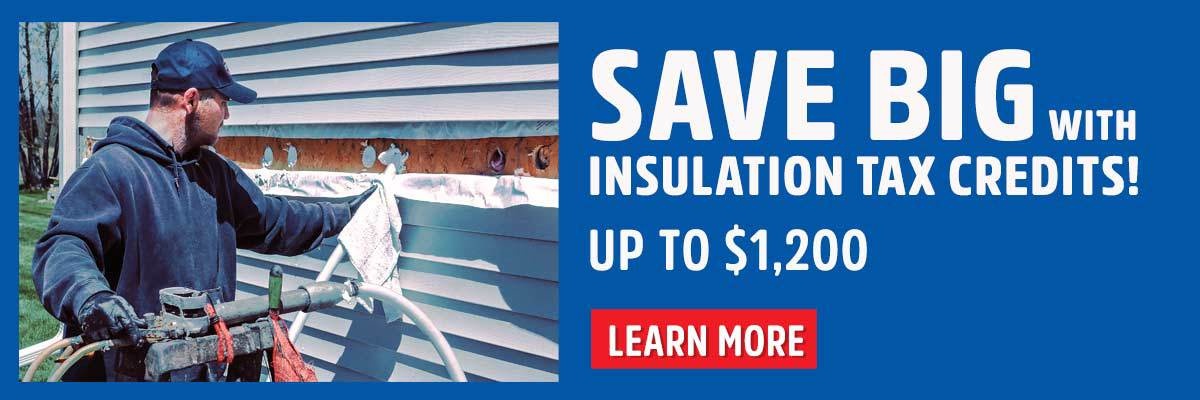The Total Lifetime Cost of Foam Insulation: It’s Less Than You Think
injection foam insulation | spray foam insulation | energy efficiency


Traditional insulation may seem like the less expensive choice for your home, but did you know in the long run foam insulation ends up being cheaper?
When considering insulation for your home it is important to look at the bigger picture – how much money will I save? Will I have to replace the material at some point? How much will home insulation cost in the long run?
RetroFoam of Michigan has more than 17 years of experience insulating thousands of homes across the Lower Peninsula and greater Toledo area, so we understand that homeowners want a product that will keep their homes comfortable while saving them money.
In our continued efforts to educate homeowners, we have broken down the things you consider before buying insulation to show the total cost of foam insulation compared to cellulose and fiberglass.
Initial Home Insulation Cost

Buying insulation for your home is a big decision that requires a lot of consideration. There are different materials to consider as well as different costs.
Some homeowners only consider the initial cost of home insulation when making a decision to re-insulate their attic, walls, crawl space, or the entire house. The initial cost is only one part to consider.
Spray foam insulation is typically two to three times the cost of traditional insulation, such as fiberglass insulation or cellulose insulation.
There are a number of factors that determine the price of insulation including the size of the area to be insulated and the type of material that is going to be used. There is also the consideration of whether you plan this to be a Do-It-Yourself project or plan to hire a professional.
Rebates for Home Insulation
How great is it to get money back from your energy provider for making energy-efficient home improvements?
Consumers Energy, DTE, and SEMCO in Michigan offer rebates to their customers when they insulate certain areas of their homes. Those rebates range between $50 and $300 per area depending on the energy provider.
While this isn’t a whole lot, it can help to lower the initial cost of your insulation project.
There are also instances where using foam insulation can earn you even more money.
Home Performance rebates from Consumers Energy and DTE are given to customers who create an air seal in their homes by adding insulation. Those customers can receive anywhere between $250 up to $1,200 in rebates as long as they meet the requirements. One of those requirements is creating an air seal.
Fiberglass and cellulose do not create an air seal, so along with not maximizing comfort and energy efficiency, traditional insulation rebates would be the lowest available.
Foam insulation on the other hand is known for its ability to create an air seal in the home. Traditional forms of insulation still allow air to either move through it or around it.
Foam insulation creates an air seal that will keep the outside temperatures out while keeping your conditioned air inside. Energy providers understand the superior benefits created by an air seal, so they are willing to offer more aggressive rebates.
RELATED: RetroFoam of Michigan Recognized for Energy Efficiency by Consumers Energy
To qualify for the Home Performance rebates, you will need to hire a BPI-certified contractor who uses the latest building science to analyze your home. The contractor will perform a blower door test before and after your insulation install to determine the reduction of airflow.
Energy Savings with Home Insulation

Are high monthly energy bills stressing you out? The addition of insulation in your home can ease that stress as long as you choose the right materials and areas to insulate.
You may not think about it, but a good portion of your hard-earned money is going right out the roof. An attic is a sneaky place where either your heated air is escaping or summer air is sneaking in.
Cold floors are another thing that can run your monthly bills through the roof. You keep turning up the heat and the floors keep mocking you with their coldness. This comes from either the crawl space, rim joist, or even your walls.
While fiberglass insulation and cellulose insulation can help with blocking some of that cold air from getting inside, it doesn’t stop it completely. Chances are you will still be dealing with bills that are higher than you want to pay.
The good thing about spray foam insulation is that it creates an air seal. That means the air you are paying to condition stays inside your home where it belongs while the outside air can’t make its way in.
Traditional forms of insulation don’t create an air seal, so air can still move around and through it. Foam insulation doesn’t allow that to happen and saves you money in the long run.
When insulating your home with foam insulation you are looking at monthly energy savings between 15 to 50 percent depending on the areas you insulate. The best bet is to insulate your entire home as it works as a system when you seal the entire building envelope.
RELATED: How Betty Jo Reduced Her Consumers Energy Bill in Half
Home Insulation Replacement Cost
Over time it is inevitable that fiberglass insulation or cellulose insulation will need to be replaced in your home. Traditional insulation materials are known to break down, sag, and shift as time goes on. The replacement rate for these materials is around 15 years, not to mention the constant maintenance like raking drifted cellulose in the attic.
Spray foam insulation and injection foam insulation never have to be maintained and never have to be replaced, as long as the product is installed properly, so it is good to hire a contractor with a lifetime warranty. Once the foam is installed in your home that is the end of it.
The only exception is when you are doing a major remodel and tearing out areas of the home where foam insulation was installed. This is the only exception to the rule because once foam insulation is installed it should last for the life of your home.
Home Insulation Repair Costs

Having the worst-case scenario happen in your home is stressful enough, but adding additional cost in the mix can make it that much worse.
If there were a flood in your home, fiberglass, and cellulose both retain water and greatly lose their R-Value when they become wet. This can also lead to the growth of mold and mildew in your home, which can be dangerous if left unchecked.
Traditional forms of insulation are known to retain any water that gets into the material. This means that water will be held against the wood frame of your home, as well as your drywall. That will leave you not only having to pay to replace your insulation, but also your drywall.
The cost to repair drywall varies depending on the extent of the damage. A homeowner could be out a few hundred dollars or a few thousand. This doesn’t include the cost to replace the traditional insulation, the cost of paint and supplies to get your home looking like it did before disaster struck, or the cost to repair the leak.
Foam insulation from the top manufacturers doesn’t need to be replaced if it gets wet, as it doesn’t retain water. An added benefit of foam insulation is that because it doesn’t retain water, it also doesn’t hold that moisture against the frame or drywall in your home.
Foam insulation also doesn’t promote mold or mildew growth.
Another problem that arises is damage to the roof when there is inadequate insulation in the attic.
The formation of ice dams causes holes in the roof and water leaks into the attic. Ice dams can also lead to wood rot, mold and mildew in the home, and damage to gutters.
Spray foam insulation combats ice dams by maintaining a constant temperature in the attic similar to the rest of the home. This will keep the snow from turning into ice and melting evenly across your roof.
Getting Started with a Free Estimate
You can’t really put a price on comfort, but now that you have seen how foam insulation can also pay you back you may be ready to take the next step.
If you would like to schedule a free estimate and live in Michigan’s lower peninsula, give us a call at 866-900-3626 or just fill out the form on our website.
Related Articles
Buying Cheap Home Insulation? Consider These 7 Things Before You Sign the Contract
How to Plan and Pay for Your Foam Insulation Cost
How Much Money Will Foam Insulation Save on Monthly Energy Bills?
About Amanda Ringler
Amanda previously has worked as a breaking news and crime reporter, TV news producer, and editor in Flint and Detroit. Throughout her career as a journalist, she has won several awards from The Society of Professional Journalists - Detroit Chapter and the Michigan Press Association. As part of the RetroFoam of Michigan family, Amanda uses her experience as a journalist to write content that will help educate homeowners on the benefits of foam insulation. When Amanda isn’t writing, she’s spending time with her husband and rescued huskies. She also loves knitting, making art, cooking, and hosting dinner and a movie night for friends and family.

.jpg)

